Wilhelm Röntgen facts for kids
Quick facts for kids
Wilhelm Röntgen
|
|
|---|---|
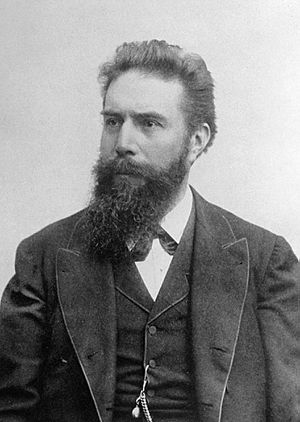
Röntgen in 1900
|
|
| Born |
Wilhelm Conrad Röntgen
27 March 1845 |
| Died | 10 February 1923 (aged 77) |
| Nationality | Prussian |
| Education | |
| Known for |
|
| Spouse(s) | Bertha Röntgen (deceased 1919) |
| Awards |
|
| Scientific career | |
| Fields |
|
| Institutions |
|
| Doctoral advisor | August Kundt |
| Doctoral students |
|
| Other notable students | Franz S. Exner |
| Signature | |
Wilhelm Conrad Röntgen (born March 27, 1845 – died February 10, 1923) was a German scientist. He was a mechanical engineer and a physicist. In 1895, he made an amazing discovery. He found a new type of electromagnetic radiation. We now know these as X-rays or Röntgen rays.
This discovery changed medicine and science forever. For his work, he received the very first Nobel Prize in Physics in 1901. Later, a chemical element was named after him: roentgenium. Even a unit of measurement, the roentgen, carries his name.
Contents
Wilhelm Röntgen: His Life Story
Early Life and School
Wilhelm Röntgen was born in Lennep, Germany. His father was a merchant and cloth maker. His mother was Charlotte Constanze Frowein. When Wilhelm was three, his family moved to the Netherlands.
He went to high school in Utrecht, Netherlands. In 1865, something unfair happened. He was kicked out of school! A teacher found a drawing of another teacher. Someone else drew it, but Wilhelm was blamed.
Without a high school diploma, it was hard to get into university. But Wilhelm was determined. He found a way to study mechanical engineering at the Federal Polytechnic Institute in Zürich. In 1869, he earned his PhD from the University of Zurich. He became a favorite student of Professor August Kundt.
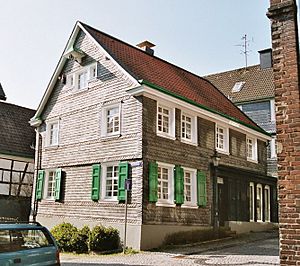

His Amazing Career
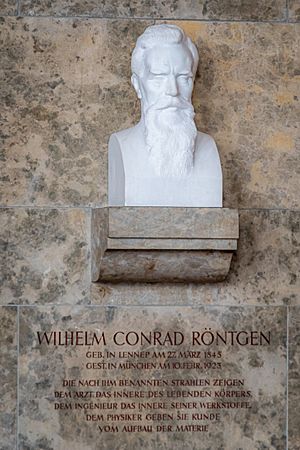
After finishing his studies, Röntgen became a lecturer. This means he taught at universities. In 1874, he taught at the University of Strasbourg. He then became a professor at other universities. These included the University of Hohenheim, University of Giessen, University of Würzburg, and finally the University of Munich in 1900.
Röntgen even thought about moving to the United States. He had family in Iowa. He planned to work at Columbia University in New York City. But World War I started, and his plans changed. He stayed in Munich for the rest of his life.
The Discovery of X-rays
In 1895, Röntgen was working in his lab in Würzburg. He was studying how electricity behaved in special glass tubes. These tubes were called vacuum tubes. He noticed something strange while experimenting with a Crookes–Hittorf tube. This tube had thick glass walls.
He had covered the tube with black cardboard. This was to block out any light. But he saw a faint glow on a screen nearby. The screen was painted with a special chemical called barium platinocyanide. This chemical glows when certain rays hit it.
Röntgen realized that something invisible was coming from the tube. It was passing through the cardboard! He called these mysterious new rays "X-rays." The "X" meant "unknown."
He spent weeks in his lab, even sleeping there. He wanted to understand these new rays. He found that X-rays could pass through many materials. But they were stopped by denser materials like lead.
One day, he held a small piece of lead in front of the tube. He saw a flickering image on the screen. It was the bones of his own hand! This was the first ever X-ray image. He was so surprised that he decided to keep his experiments a secret for a while. He worried people might not believe him.
About six weeks later, he took an X-ray picture of his wife's hand. Her name was Anna Bertha. When she saw the bones of her hand, she famously said, "I have seen my death!" This was the first medical X-ray image ever taken.
Röntgen shared his discovery on December 28, 1895. News spread quickly around the world. People were amazed by the "new kind of rays." His work led to the field of radiology. This is a medical field that uses imaging to diagnose diseases.
Personal Life
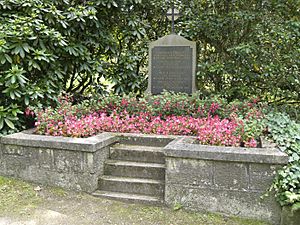
Wilhelm Röntgen was married to Anna Bertha Ludwig for 47 years. They met in Zürich in 1866. They got married in 1872. Anna was six years older than Wilhelm, and his father didn't approve at first.
They adopted a daughter named Josephine Bertha Ludwig. She was Anna's niece. They adopted her when she was six years old, after her father passed away.
Röntgen was a very ethical person. He never tried to get patents for his discovery. He believed that X-rays should be available to everyone for free. He even donated his Nobel Prize money to research at the University of Würzburg.
He was offered a special title of nobility, but he turned it down. He didn't want to be called "von Röntgen."
After World War I, there was a lot of inflation in Germany. Röntgen lost much of his money. He spent his last years at his country home near Munich. He passed away on February 10, 1923, from cancer.
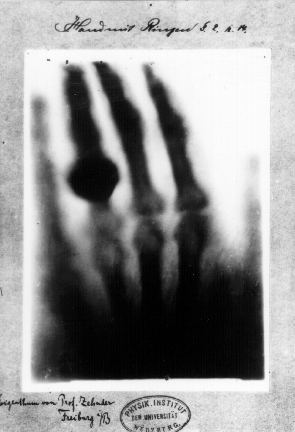
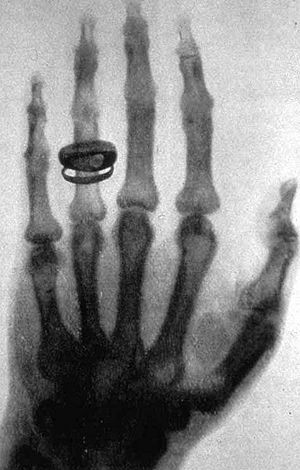
Awards and Honors
In 1901, Wilhelm Röntgen received the very first Nobel Prize in Physics. He was honored for his "extraordinary services" in discovering X-rays. As mentioned, he gave his prize money to his university for research. He wanted his discovery to help everyone.
Some of his other awards include:
- Rumford Medal (1896)
- Matteucci Medal (1896)
- Elliott Cresson Medal (1897)
- Barnard Medal for Meritorious Service to Science (1900)
- In 2004, the IUPAC named element number 111, roentgenium (Rg), in his honor.
His Legacy Today
Wilhelm Röntgen's discovery changed medicine forever. X-rays are now used every day to see inside the human body. They help doctors diagnose broken bones, illnesses, and more.
There is a museum dedicated to him in Remscheid-Lennep, Germany. It's called the Deutsches Röntgen-Museum. In Würzburg, you can visit his laboratory. It is now the Röntgen Memorial Site.
World Radiography Day
Every year on November 8, people celebrate World Radiography Day. This day marks the anniversary of Röntgen's discovery of X-rays. It celebrates how medical imaging helps healthcare around the world.
Other things named after him include:
- Röntgen Peak in Antarctica
- Minor planet 6401 Roentgen
See also
 In Spanish: Wilhelm Röntgen para niños
In Spanish: Wilhelm Röntgen para niños
- German inventors and discoverers
- Röntgen Memorial Site

